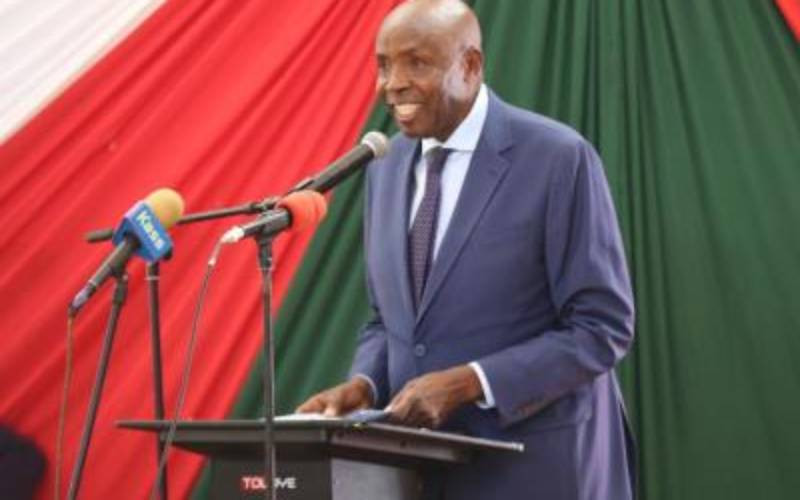The release of Form Four exam results last week came as a surprise to many. But it wouldn’t have been a shocker if Education Cabinet Secretary Fred Matiang’i had made prior full disclosure on measures put in place to make exam results credible. Everybody knows that Dr Matiang’i sealed all loopholes for exam leaks and cheating. He deserves a bouquet for his efforts.
But there is more to last week’s results, which Matiang’i did not tell Kenyans. Only education mandarins and veteran examiners know that last year’s Kenya Certificate of Secondary Education (KCSE) exam results were not standardised as had been the practice before.
This means that the shock that reverberated across the country last week was more to do with lack of standardisation and less of Matiang’i reforms combined.
From what I know, the first KCSE exam results released in 1990 under the 8-4-4 system were not standardised. In fact, only one student scored an A grade.
There was double intake for the four public universities then. KCSE candidates who scored C+ and above were absorbed as well as the last Form Six candidates who qualified. And for four years or so, the performance in KCSE appeared normal.
Things changed when politicians started demanding university campuses to be set up in their villages.
According to insiders, the Kenya National Examination Council (Knec) has for years been recalibrating grading scales depending on performance to achieve a ‘normal’ performance curve. For example, if Knec established that there was poor performance in mathematics, it could lower the cut-off mark for grade A to say 60 per cent.
This means that for all students who scored between 60 and 100 per cent, their marks would be recalibrated using a formula only known to Knec to get enhanced marks in the range of 80 to 100 per cent that make for grade A.
It is this standardisation that Matiang’i decided to drop. But there were hints that standardisation of results would be stopped. While addressing education county officials last year, Knec Chairman George Magoha averred that ‘the stupid A’s’ scored in previous years would not be seen under his reign.
Unbeknown to Matiang’i, he has opened a Pandora’s Box that could be his waterloo. Education in Kenya has political and commercial interests. Matiang’i failed to grasp the political implications while Prof Magoha appears not to have briefed him on commercial aspects.
Let’s look at some of the implications. Only the 31 public universities will absorb those who scored C+ and above. This means that for a full academic year, there will be no freshmen for parallel degree courses since students with C grade don’t qualify to join universities.
Consequently, universities will be starved of extra income to supplement limited government capitation. Most of them will most likely shut their campuses, sack part-time lecturers and other lower cadre staff. The impact of a missing class will be felt for four successive years.
Private universities will also go for a whole academic year without students. Consequently, those that have taken loans to invest will default. Middle-level colleges like KMTC will have to lower their intake grade to C and below. And how would grades in post-Matiang’i era compare with those awarded during standardisation regime?
Students who sat KCSE exams in 2016 will be unfairly treated in the job market. The biggest tragedy is that parents are now left with about 190,000 students who scored D- and below. This is not a laughing matter.
The Government has been boasting about massive school intake and ‘free’ education without looking at the post-secondary transition.
Stay informed. Subscribe to our newsletter
The students may have failed because the Government is unable to employ enough teachers. Examiners were also not given a chance to assess whether the 2016 exams were tougher.
We have unfairly condemned the 2016 class as academic dwarfs and their teachers as cheaters who were stopped in their tracks.
 The Standard Group Plc is a
multi-media organization with investments in media platforms spanning newspaper
print operations, television, radio broadcasting, digital and online services. The
Standard Group is recognized as a leading multi-media house in Kenya with a key
influence in matters of national and international interest.
The Standard Group Plc is a
multi-media organization with investments in media platforms spanning newspaper
print operations, television, radio broadcasting, digital and online services. The
Standard Group is recognized as a leading multi-media house in Kenya with a key
influence in matters of national and international interest.
 The Standard Group Plc is a
multi-media organization with investments in media platforms spanning newspaper
print operations, television, radio broadcasting, digital and online services. The
Standard Group is recognized as a leading multi-media house in Kenya with a key
influence in matters of national and international interest.
The Standard Group Plc is a
multi-media organization with investments in media platforms spanning newspaper
print operations, television, radio broadcasting, digital and online services. The
Standard Group is recognized as a leading multi-media house in Kenya with a key
influence in matters of national and international interest.







